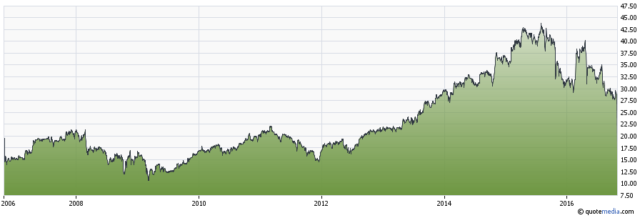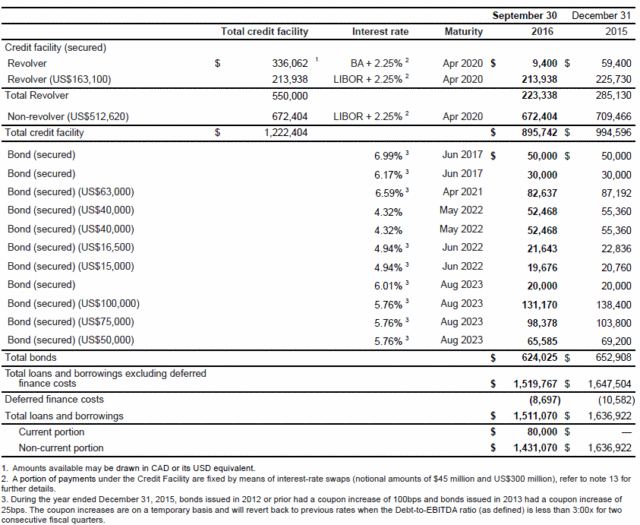Once upon a time, I had invested some money in David and Henderson Income Fund, which was back in the days when a lot of viable corporate operations were structured in the form of an income trust. I made some reasonably quick capital gains, sold, and never looked back.
Davis and Henderson, similar to Kentucky Fried Chicken, Ernst and Young, PriceWaterhouseCoopers and many other establishments, decided to abbreviate their corporate name to their initials and become D+H Corp (TSX: DH). Considering that their previous business was the printing and processing of Canadian (paper) cheques, diversification of their business was correctly considered and for the most part, they made a fairly good transition into the broader realm of providing financial technology services for big banks.
You can see in the 10-year chart that this has really worked for them, and the market has been on their side, until recently:
What you don’t see is that in today’s trading, they fell 43% on a quarterly announcement (closing at $16.25/share, with a low of $14.97), bringing their stock price to levels frighteningly close to what I had invested back in 2010 with a cost base of $16.10 per unit. This was certainly a case of “back to the future” for Davis and Henderson.
The question of course is whether the six or so years it has been since I had last invested in them, whether they were worth taking another stab at again.
D+H’s fateful decision was the acquisition of Fundtech on March 30, 2015 (which closed a month later). In this acquisition, they issued many hundreds of millions of debt (in addition to doing a secondary offering at $37.95). Unfortunately, while the acquisition was designed to represent a diversification away from their traditional businesses, it has not materialized into anywhere that could be financially rationalized with the price paid. It has also bloated D+H’s balance sheet with the haunted scars of an additional $1.7 billion in goodwill and intangibles, and when considering their pre-existing goodwill and intangibles, they are sitting on a negative $1.3 billion of tangible equity.
Putting this into plain English, their balance sheet is a train wreck.
Train wreck balance sheets can only sustain themselves with positive cash flow, and continued good credit, as the generosity of lenders will be able to see them through.
For the first 9 months of the year, they have generated $167 million in free cash flow. A majority of this goes to dividend payments ($90 million), and the rest of it goes to debt repayment and acquiring other intangibles.
The problem is with the last quarterly result – it is quite evident that the corporation, on a consolidated basis, has flat-lined. While they still generate a very healthy amount of cash, it is obvious that they will be receiving future stress in the form of being able to repay debt as it matures.
They face the following debt situation:
They have an immediate maturity coming in June 2017, which they should be able to pay off with existing cash flow and/or their revolver without issues. The issue is what happens when they start getting into the bulk of their 2021-2023 maturities.
The math is simple – if they continue paying dividends at their current rate, they will have about $100 million a year in cash to acquire businesses (more intangible assets on the balance sheet) plus debt repayment. They will not have nearly enough to pay off the bond maturities without getting another extension of credit from bondholders.
Considering all of the bond issues and the revolving facilities are secured debt, you can be sure that the banks that supply the revolving debt are going to be nervous about using their money which is pari-passu to bondholders – which means that something is going to have to be negotiated in a couple years.
My guess is that the dividend is going to get slashed in half.
In terms of valuation, the balance sheet situation would make me quite uncomfortable as an equity investor. While I see the value in the cash generation potential of the underlying businesses (notwithstanding the fact that cheque processing is a dinosaur industry and is decreasing accordingly), I do not believe a leverage-adjusted valuation of this business is attractive at present prices.
For now, D+H is still a “pass” in my books. I did sell them at $21 back in the year 2010.


thanks for the heads up…..what are their 2017 bonds priced at?
Can’t find a quote on them.
[…] Divestor took a closer look at DH Corp, which was down approximately 40% this week. It yields more than 7%, a payout he does not think is […]
[…] I looked at D+H Corporation’s (TSX: DH) last disaster of a quarter and predicted the following: […]
[…] in October 2016 when they released their disaster of a quarterly earnings report, their stock subsequently traded as low as CAD$14.06, although realistically if you had started […]